Pozo legend: Dunkerbeck, Moreno, Pons and co. on the legendary spot on Gran Canaria
SURF Redaktion
· 24.08.2024






None, the silhouette of Pozo really isn't a beauty. But almost every windsurfer recognises the place from photos straight away. For over 30 years, the characteristic images of the World Cup on Gran Canaria have been burnt into every windsurfer's brain. The towering jumps in front of the house fronts assembled from Lego bricks as if by a five-year-old and the wind rotors in the background leave no doubt. For many wave purists, for whom a wave is only a wave if it feels like you can ride it for kilometres downwind, a wave contest in Pozo is actually completely unacceptable. However, for those who like spectacular aerial shows, Pozo is the Mecca of windsurfing.
More about Pozo:
The spot with the beach of lava bowling balls and the eternal strong winds has produced some of the best and most successful windsurfers in the world. First and foremost the record-breaking world champion Björn Dunkerbeck, whose son Liam is preparing to follow in his father's footsteps. Or the Moreno twins Daida and Iballa, who are the most successful female windsurfers in history. Five-time wave world champion Philip Köster also grew up with Pozo's hack. And now Pozo youngsters such as Marino Gil Gehradi and the German-Spanish siblings Alexia and Carlos Kiefer are shaking the throne of the established wave rulers. So what's the story behind the Pozo Izquierdo myth?
Interviews: Robert Almquist & Kritoffer Living
Björn Dunkerbeck
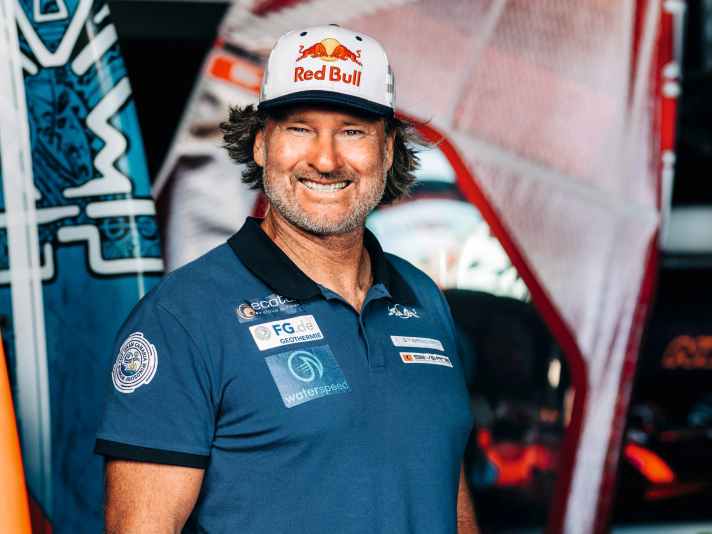
Björn, you've been organising the World Cup Pozo for three years, which was held for the 36th time in 2024. You were there right from the start. Can you still remember the first time you surfed in Pozo?
Sure, the first time I was here was in 1981, on a board that was only 195 centimetres long - I was only 13 years old. Pozo was tiny, only about 20 people lived here. There were no restaurants, no flats and no wind turbines, just dust, stones and a small café. The café is still there, by the way. In the meantime, Pozo has developed quite a bit. There are surf shops and infrastructure, and thousands of windsurfers come here every year. Of course, the World Cup has also contributed to this.
How did it come about that Pozo became the location for a World Cup?
My parents, Ulla and Eugen, came up with the idea back in 1989 and wanted to organise a World Cup in a place with strong, reliable winds. Back then, spots like Sylt, Scheveningen and Maui were on the tour plan - great places, but not absolutely wind-safe. You first organised the event on your own, then with a small team. The judges sat on the shore and had to make sure that everything didn't blow away while they were noting down the points. Improvisation and an idea turned into 23 years of a professional World Cup, after which Daida Moreno took over the organisation for ten years, and it has been in my hands for the last three years. And of course I hope that many more events will follow here.
Let's look back even further: Who actually discovered Pozo back then?
My parents had their windsurfing centre in Maspalomas, where my sister Britt and I learnt to windsurf. From Playa Ingles you could always see this white stripe far out, obviously the wind there was much stronger than ours. It was the time when we learnt to ride shorter boards. Foot straps and harnesses came up and we surfed on boards from JJ-Customs. So one day we put our boards on the roof of a Seat 127 and drove up the east coast of Gran Canaria. We first ended up in Vargas, where there was at least a small road. Further north, we discovered Ojos de Garza, where the wind was a little lighter. The first person to windsurf in Pozo was Claus, a German. He discovered the small path that led there and told me about it two days later. We went there often after that, simply because it was much quicker for us to get there than Vargas, where you had to windsurf halfway across the island.
Pozo became your second home ...
I spent so many hours on the water in Pozo, it must have been thousands. But because I was still too young to drive myself when I discovered Pozo, I always had to hope for a lift. My parents often dropped me off here in the morning before they had to go to work at the surf centre and then picked me up again in the evening when I was completely exhausted (laughs). Pozo has made me what I am. Training at Sturm has helped me all over the world in all these years.
What is decisive in the competition in Pozo in order to achieve something?
If you want to succeed in the World Cup here, you need a lot of training hours on site. Pozo is unrivalled. That's why many top riders come here a month before the World Cup to train. In Pozo you don't jump, you fly. Nowhere else in the world can you get so high in the air, ten, twelve, 15 metres. But you need courage, a lot of training time and you have to be able to take it. Training gives you control in the air at some point. And without control, you have no chance here.
Where do you think the Pozo World Cup will be in a few years?
I don't think much will change. The trade wind is blowing like every year and I see so many kids out on the water here. All the youth classes, such as the U-21 and U-18, were full this year, and there will be classes for U-15 and U-13 in the coming years. When the kids are out here, that's the sight that makes me most happy as an organiser. We are working on organising a budget with which we can realise a duration of two weeks. Then the chance of great conditions would be even greater. And the more spectacular the action, the more interesting the event is for sponsors.
Liam Dunkerbeck

Liam, you don't live directly in Pozo, but only ten minutes away by car ...
Yes, exactly. I'm in Pozo almost every day, even when there's no wind. I like the place and its people. The people here are very friendly and help each other as much as they can - the atmosphere is very relaxed and as a windsurfer you meet a lot of like-minded people in this small town. My father has also just opened a new shop in Pozo, check it out.
What do you think pozo means for windsurfing in general?
Thanks to Pozo, the sport is constantly reaching new heights - literally. The Pozo World Cup encourages riders to push their jumping level further and further.
Marino said you have to have a lot of guts to push yourself to the limit in Pozo ...
Yes, that's probably true. If you go out here on a day with a lot of wind and good ramps, you have to leave your head on the beach. It's best to leave it in the car and lock the doors (laughs). Then it really is: Just go for it!
What is your favourite Pozo memory from the last few years?
The summer in the corona year, when no event could take place, was incredibly good in terms of conditions. It was one of the windiest summers I can remember. Marino (Gil) and I felt like we were almost alone on the water every day and were able to push our level like never before. It was crazy.
The Pozo World Cup encourages riders to push their jumping level further and further."
Josep Pons
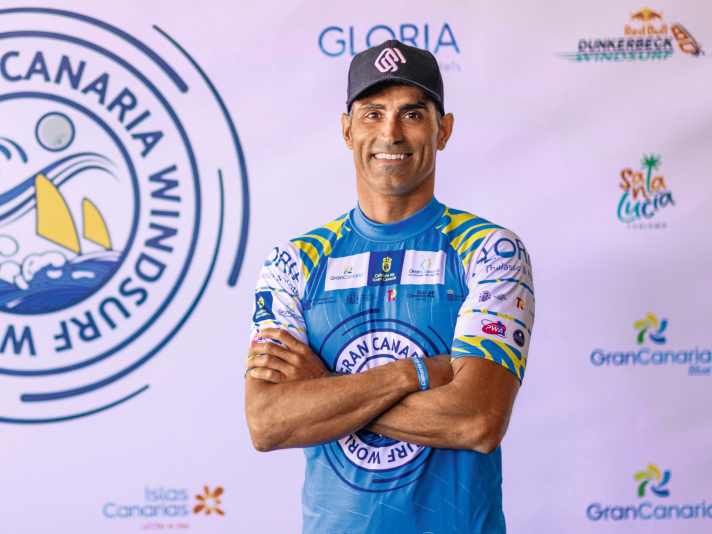
Josep, Pozo is your home spot. You've been training here for ages but have never been able to win. What makes Pozo so difficult?
I think the level is just insane. I've got all the moves and the level to do well here, but of course a contest is always different to free surfing.
Pozo is always similar. Have you ever had the feeling that you're getting bored here
I appreciate Pozo even more than before. Yes, there are chops, there are gusts, and when you surf Pozo for the first time, you fall away from faith and think to yourself, "What am I doing here?" But eventually you get into the groove and can enjoy it. For me, it's one of the best spots in the world. Everyone knows Pozo. There's Maui and Pozo, they're the two most famous spots in the world. No other spot is as consistent as Pozo. You can systematically improve your level here.
Are you sometimes still afraid when jumping?
When I came here, over 20 years ago, I was flashed when I jumped. I saw in the photos that I wasn't even a metre high (laughs). Of course, you push your own fear threshold further and further over time. But even today I still have this feeling sometimes. Then I look down from a height of ten metres and am startled: "Oops, that's high!" From the outside, it always looks as if the top riders are brave beyond belief because they do crazy things. But we do it because we have the feeling that we can control it. And if I don't get that feeling on a jump, I get off just like any amateur surfer.
You are also active as a coach for many top riders. Is this the perfect place for that?
When it comes to jumps, definitely. I have coached many top riders over the years. Just this morning, Thomas Traversa asked if we could do a coaching session for the double forward. And Pozo is the perfect place for that.
Are there days when you hate Pozo?
In high summer I sometimes go out somewhere else, it's too stressful for me here, especially on the days with small waves when everyone is surfing at the bunker.
We're talking about professionals here. Can't Pozo be intimidating for amateur surfers who come to you?
It's difficult at first, but on the third day you start to make progress. At other spots, you have a good day and then another ten-day break. Here you get into the groove and can make real progress within a few days. If you really want to learn something new, the fear usually quickly fades into the background. And a little tingling in the stomach is also part of it (laughs).
Philip Köster tried another triple forward here during the event. Would that be something for you too?
I was injured for a while before the event. The first double I did after the break, I over-rotated and crashed after two and a half rotations. That's when I realised again that I didn't feel ready for the triple. But I believe that the jump is generally possible.
Nico Prien
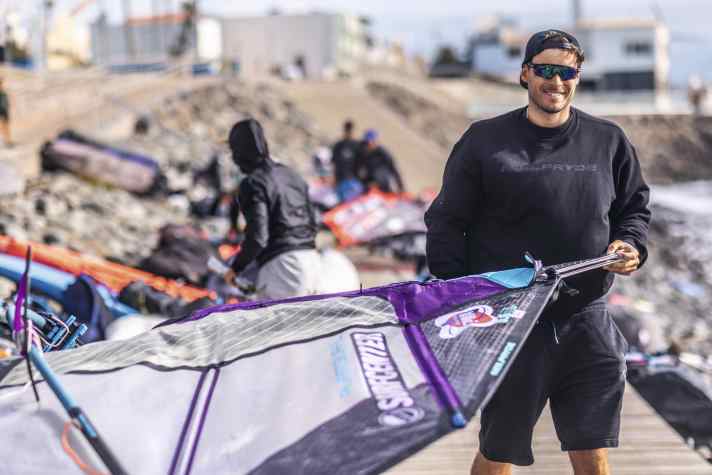
We're here with Nico Prien, the jack-of-all-trades of windsurfing: shop owner, successful Youtuber and equally successful professional surfer and, more recently, PWA President. Is there anything you can't do?
There are a lot of things I can't do. Nobody says I'm good at the things you mention, so I'm probably not so good at some of them, I guess (laughs).
You are competing here in the new Slalom-X discipline. What does Pozo mean to you?
Pozo is a special place because the conditions are very rough and it's super windy. And it's the first place I travelled to alone and without my parents. I came here when I was 14 to surf the waves. So I have fond memories of Pozo. For us, this is the second year after a long break that we are competing in the slalom here again. So for the younger guys at least, everything here is new. But Pozo also has a great tradition in slalom. Yes, Pozo is something very special, and if you're at the front here, it means you're a good surfer.
What do you need to do well under these extreme conditions?
I would say if it's not that windy, it can be quite a relaxed spot. But the thing is that it's usually quite windy and then you need big balls. That applies in the wave, but also in the slalom, because you have to keep everything under control. There is a big, rolling swell far outside the starting area, you have to deal with that, but also with the surf in the shore area. If you don't have this under control, it can have nasty consequences and you can take a really nasty tumble. You really have to want it and push yourself hard, otherwise you'll slow down, and we don't want to be slow, we want to be fast.
You have to perform over several days and several laps. So it's different to just completing a test run or a speed run. You have to stay fit throughout the week and perform until the very last race. Here in Pozo, it's not just about how much energy you have, but also about how you can conserve your energy for the whole week. You can't really hold back because everyone is going full throttle from the first to the last minute. So of course the energy level drops a bit, but for everyone. So it really depends on who can maintain the energy level until the end of the event. It's partly down to the body and how you prepare and how much you've trained with Fin, but of course it's also down to the mind.
When I took part in competitions many years ago, I was really impressed by what Björn did. He was really good at conserving energy. He knew what was important and had a caddy who took everything off his hands as soon as he got off the water. I wish I had a guy like that. But it's about saving energy. When your race day is over, another race starts - whoever gets home first, whoever rests, cooks, eats and makes sure their batteries are charged for the next day. So after the race is before the race, so to speak.
What do you think Pozo has meant for the sport of windsurfing?
I think Pozo has had a big influence on windsurfing because it introduced a lot of new moves like push forwards, double forwards and even triples. So this is where windsurfing really reaches its limits. This has a huge impact on windsurfing, and the same goes for slalom. We will push the sport to its limits. We will simply get the maximum out of the sport, and that's what Pozo stands for to me.
It's about recharging your batteries as quickly as possible."
Is there a very personal story that connects you to Pozo?
I was only travelling in the wave when I was twelve or 13. I dreamed of coming here back then. And I remember chatting online with Alessio Stillrich because he was living exactly the life I wanted to live, namely surfing the waves every day. And then, when I was 14, I came here with a friend, Frithjof Blaasch. He was a bit older and we just surfed here for a fortnight. Going out with Moritz Mauch and Alessio was just super cool and inspiring for me.
Where do you think Pozo will be in ten or 20 years' time?
Well, that's a difficult question. Some of the young people have this vision that Pozo will be a kind of hub for European windsurfing. But the point is that Pozo is a really difficult spot. It's not suitable for everyone. Just getting into the water over the rocks is difficult. And the conditions outside are really rough. So it will always be a spot for advanced surfers. But that's why it will also remain a spot where you will always see windsurfing at a very high level - and that will continue to develop. If you want to make it to the top in wave surfing, you have to come here once or more often. So Pozo will definitely become a high-performance windsurfing spot. I'm excited to see what will develop here. The conditions on the water will remain the same. They have remained the same for so many years. It will always be a kind of skate park.
Alessio Stillrich
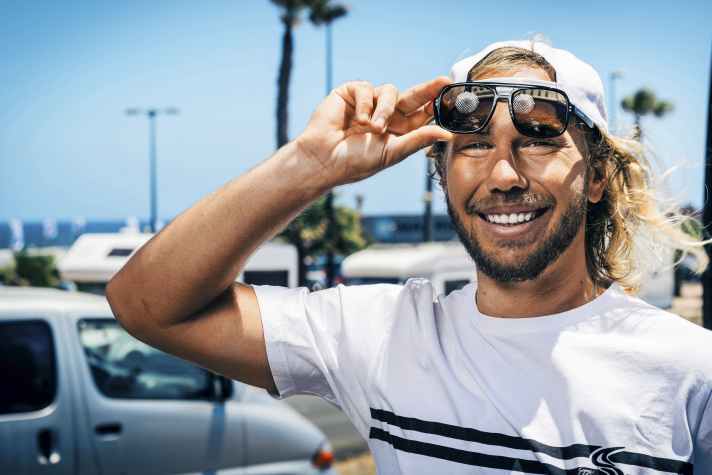
Alessio, what does pozo mean to you?
Pozo means everything to me! I mean, I basically grew up here, spent so much time on the water and between sessions on the beach or in town. I know everything and everyone here.
Have you lived in Pozo all your life?
No, I was born in Gran Canaria, but I used to live in the south of the island, but I still came here almost every day to surf. Since I was 18 years old, I've had a small flat here right by the spot, where I've lived ever since. I feel very much at home in Pozo and get out on the water an incredible amount.
Did you learn to surf in Pozo?
Nene, that was a few kilometres north of here. There is a good beginner's spot not far from Pozo in the shelter of the harbour basin of Arinaga. Pozo itself is not so beginner-friendly (laughs).
I didn't learn to surf in Pozo. The spot isn't exactly beginner-friendly."
What makes the spot in Pozo so special for you?
Especially the consistency, there are just so many windy days in the year. And also the exceptionally good jumping conditions to shoot out really high.
Where do you see Pozo in ten years' time?
Not too much has changed in the last ten years since I've lived here, I have to say, and I don't think it will change that much in the next ten years either - the wind will stay, the waves will stay (laughs). However, more and more people are coming to Pozo - which is nice to see and good for the sport, but on the other hand, Pozo bay is not the biggest and it can get really crowded on the water. I've also heard that a new apartment complex with lots of flats is to be built in the first row on the beach.
Daida Moreno
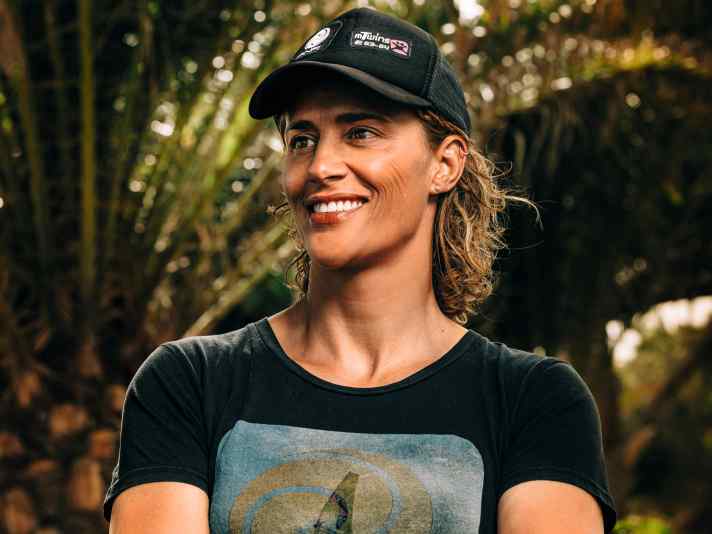
Daida, you are an 18-time wave world champion and have won 20 times here in Pozo. An impressive record.
1997 was my first event here in Pozo, and from 1999 to 2023 I always won with two exceptions. In 2012, I had just come back from chemotherapy after my cancer, and in 2013 there was no wind.
How did you discover Pozo?
My grandma has always lived here, and when I was five years old, my father bought a piece of land in Pozo and built a house. So you could say that I've practically spent my whole life here. I started windsurfing with my sister in 1995. Pozo means everything to me. I grew up here as a woman, I became world champion here, all my friends and family live here and my son is growing up here. Pozo has given me the opportunity to make a living from windsurfing over the last few years. It's in my blood.
What does windsurfing mean for Pozo, and what does Pozo mean for windsurfing?
Pozo lives from windsurfing. There is wind here almost every day, there are often waves and the weather is good. That's why tourists come here to surf, there are surf shops and people live from windsurfing. On the other hand, there has always been a World Cup here for decades with great competitions. It's all about windsurfing here. We get up every day and look at the wind and wave forecast.
How do you think Pozo will develop in the future?
It will grow, there will be more shops, a pharmacy, more people. It will therefore presumably lose a little of its magic as a village where everything revolves around windsurfing. But there will also be more kids windsurfing and more windsurfers in general. Even if there are other sports such as wingsurfing or kitesurfing, Pozo will always remain a magical place for windsurfing.
Pozo gave me the chance to make a living from windsurfing. It's in my blood."
You were always very focussed on the competition, but windsurfing is also a special lifestyle.
That's right, my life consisted of training, travelling and competitions. Now that my competition career is over, I can feel and live the lifestyle much better. Windsurfing now means going out with friends, living healthily and sharing your passion. The young kids are living their dream here, and we older ones are also living our own dream. I'm pushed by the level of the youngsters, I'm always trying to get better and the kids help with that - even if it's sometimes frustrating to see what they do. I certainly won't be jumping a stalled double again - as a physio I can see the dangers - but modelling myself on the youngsters makes me better and keeps me young.
What do you need to surf really well in Pozo?
It's a mixture of Marino Gil and Liam Dunkerbeck. You definitely need the self-confidence and courage that Marino has, but also the modesty and eagerness to train that Liam has. That's the perfect mix. Personally, I've always had to work very hard. I might not have the most outstanding talent, so I had to learn all the moves with a lot of hard work and training. Some of the kids, on the other hand, learn all kinds of impossible manoeuvres in a very short space of time.
Do you have a very special magic moment here in Pozo that you remember?
Yes, it was the day I learnt the front loop. At the time, my twin sister Iballa and I were still sharing the equipment we had borrowed from Jonas at Pozo Winds. After Iballa came off the water and I took over the equipment, I said to her that I was doing the front loop today. And I went out and rotated the first one. I was all dizzy and Iballa ran to the pozo wind shop and got all the people. They stood on the beach and I did one front loop after another. That same day, Iballa also learnt the front loop.
Marino Gil Gherardi
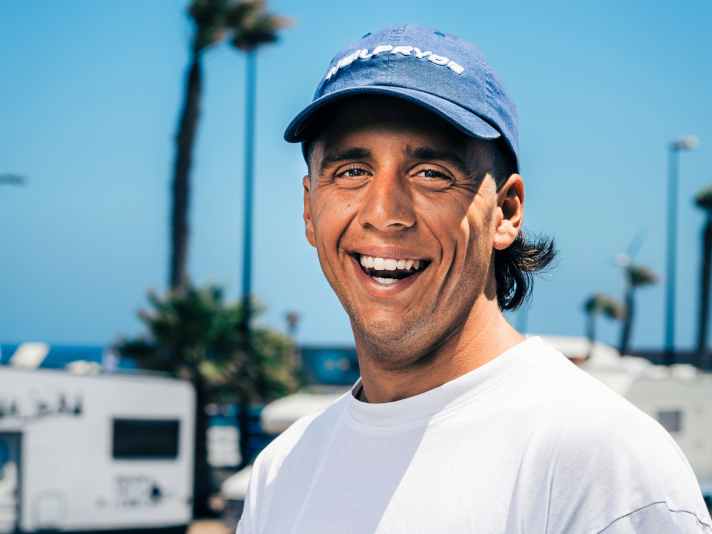
Marino, what is the most important thing for you when surfing in Pozo?
Staying focussed and maintaining concentration is particularly important here, I would say. It's so damn windy out there, the slightest mistake due to lack of concentration can have devastating consequences. And you always have to be prepared for everything here and keep an eye on a lot of things at the same time. The rocks, the strong gusts of wind, the mob of people on the water in summer - it can get very intense.
What attitude do you take to the water here?
You have to show backbone and courage in Pozo if you want to get something. Just to compete against the really good surfing locals and catch good waves, you have to be competitive to a certain extent, even in free riding.
How do you motivate yourself to push yourself to the limit every day?
Quite simply: I want to become world champion! I want to be ready for anything and always jump the latest moves. That's already more than enough motivation.

